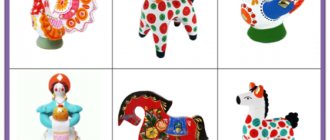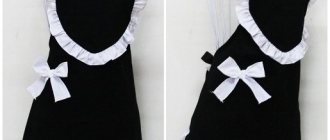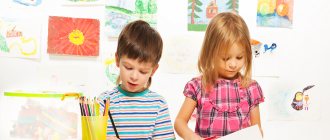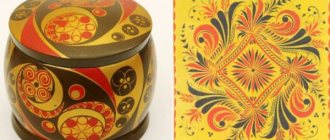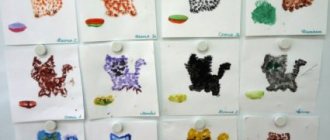Preparation for a class in decorative drawing in the middle group.
In the younger groups of kindergarten, children completed drawing tasks on paper blanks in the form of items of clothing (dress, scarf). Drawing was decorative in nature, but was aimed at honing the skill of working with a brush and paints: drawing straight horizontal and vertical lines along the edge of the workpiece, drawing dots within the designated contours. Direct instruction in decorative drawing begins in the middle group. The teacher introduces the children to folk crafts and highlights the features of Dymkovo, Filimonov, and Gorodets paintings. Through the study of objects created and painted by folk craftsmen, children learn to respect manual labor and see beauty in interior items, clay and wooden toys. There is a desire to create patterns yourself.
Class on decorative drawing in the middle group
Objectives of teaching decorative drawing in the middle group:
- Sharpening technical skills. Children 4–5 years old create patterns from dots, lines, simple geometric shapes using a brush and paints or a pencil.
- Development of compositional skills. Children master the concepts of “symmetry” and “rhythm”, learn to place patterns on the surfaces of objects of different shapes.
- Development of a sense of color. The teacher teaches the children how to mix colors and use contrasting color combinations in a pattern.
- Learning the ability to distinguish between different types of folk painting and perform individual elements in your own works.
Class on decorative drawing in the middle group
Lesson materials
For decorative drawing in the middle group, it is recommended to use figured blanks made of thick paper (for watercolor or gouache) or cardboard. Blanks in the form of dishes (cups, spoons, plates), clothes (apron, dress, sweater, mittens) or toys can be cut out in advance and stored in a closet with materials for art classes. Another option for decorative painting is to use a template. The children are given cardboard templates of a sweater; they must trace it with a pencil on a sheet of paper. In the middle group, you may not be given the task of cutting along the contour to save time, but those of the children who can quickly cope with drawing a pattern should be asked to cut out a decorated object.
Colored paper or cardboard is also used as a base. Bright material attracts children's attention and develops the ability to combine pattern and background colors.
Figured blanks for thematic classes on decorative drawing can be assigned to students at home together with their parents and brought to the next lesson for decoration with a pattern. For example, on the weekend you are given the task of preparing a blank cut out of thick paper for the lesson “Decorating a Sweater” . The creative process for the guys will begin from the moment they choose the style of the sweater (wide or narrow, sleeves with or without elastic bands, a collar with a collar or a crew neck, or it is missing, and then you need to decide on the shape of the neck) and the color of the paper from which the blank will be cut. As an idea, the teacher can suggest that parents find embossed paper. It is sold in specialized craft stores, has a textured surface and will serve as a material for various crafts, including making a sweater.
Base material option
This theme can be used for a short-term project - “Decorating a sweater for your favorite toy . The child chooses which toy he wants to decorate a sweater for as a gift, and the parents help draw the outlines of a suitable sweater. At home, children can try cutting out the blank themselves.
Options for templates for the “Sweater” blank.
Sample
Template Template Template Template Template
In decorative drawing classes in the middle group, children draw with colored pencils, wax crayons, watercolors and gouache. Pupils are given freedom of choice (paints or pencils) during classes aimed at reinforcing decorative drawing techniques.
Techniques and techniques of drawing in the middle group.
Children 4–5 years old learn to hold a pencil correctly. They trace the templates along the contour, draw patterns of straight and curved lines, simple geometric shapes. In the middle group, learning pencil shading begins: painting circles and ovals with lines in one direction, without going beyond the contours.
Much attention is paid to the development of painting skills. Children consolidate their skills in working with a brush: wetting, picking up paint, mixing paints, painting with the whole bristles or the tip of the brush. Middle-aged preschoolers create a pattern using the following drawing techniques:
- Strokes . A simple decorative element that does not require extreme precision. The children create a pattern by lightly applying brush bristles to the paper. The tasks to consolidate this technique include mastering the technique of alternation: strokes of paints of different colors are applied in a certain order.
- Dots . A more complex element, children must learn to paint with the tip of the brush in a vertical position. The dots are placed in a certain rhythm within the contours of the decorated workpiece. In contrast to the tasks in the younger group (“Using dots, depict snow, raindrops, berries, grains for the birds”), children are asked to draw a pattern with dots in accordance with the plan: parallel rows, a checkerboard pattern, or a dotted outline of a figure, for example, a circle. The skill of alternation is first consolidated in completing the task of drawing dots of different colors, then develops when drawing dots and strokes in a given order.
- Rings and circles . Children learned to draw these elements in younger groups. In decorative drawing classes, their implementation becomes more difficult: the children must draw circles and rings of the same size.
Initially, children are taught the simplest compositional technique in creating an ornament - repetition, after which - alternation. The skill of creating a linear pattern on strips of paper or along the edges of blanks (the hem of a dress, the rim of a cup) is reinforced. Using blanks in the shape of a square or circle, children learn to determine the center of the figure, draw a pattern in a circle or with a rotation of 90 degrees.
The use of other types of visual activities and non-traditional techniques.
In decorative drawing classes, techniques from other fine arts activities, such as appliqué and sculpting, can be used. The image with an ornament is complemented by design with elements made of paper or plasticine. For example, paper strips can be glued to mitten-shaped blanks - these will be knitted elastic bands; the sundress blank can be decorated with an applique in the upper part - decorate the sundress bodice; you can add plasticine balls to gloves, a hat or a sweater to imitate wool pompoms; decorating the finished work with small plasticine balls - beads, beads or buttons on items of clothing and hats.
In classes on creating patterns, the following non-traditional drawing techniques can be used:
- Finger painting. Children aged 4–5 years still retain an interest in drawing with their fingertips and palms.
- Printing - creating a pattern by dipping in paint and applying pieces of foam rubber, leaves, buttons, etc. to paper.
- Pointillism is drawing with dots, usually using cotton swabs.
- Monotype is a technique of a single print. The ripples draw on one half of a symmetrical blank, without allowing the pattern to dry, fold a sheet of paper in half and get a mirror print.
- Drawing with wax crayons and watercolor filling. The children draw a pattern with a wax candle or chalk, then completely paint over the blank with watercolors (on top of the wax pattern). When the paint dries, the wax contours appear beautifully.
- Scratching is the scratching of a design on dried gouache, under which there is a colored wax background.
Examples of work performed using non-traditional techniques.
Finger painting Finger painting Button printing
Drawing with cotton swabs
Monotype Drawing with cotton swabs
Finger painting
Scratch
Scratch
Drawing with cotton swabs
Individual tasks for decorative drawing classes.
Educational activities in kindergarten are implemented within the framework of a personality-oriented approach. This means that when conducting classes (including visual arts), the teacher must take into account the developmental characteristics of each child, their level of proficiency in certain skills, and their emotional state at a particular moment. Since practical activities in decorative drawing are aimed at achieving the goal of creating a pattern on a given surface, the main task should be accessible to all students. If a child experiences difficulties, the teacher uses the technique of individual demonstration of actions. In the middle group, it is acceptable for the child to repeat the teacher’s actions.
For those children who successfully cope with the given practical task, the teacher must provide individual assignments.
Let's consider options for individual tasks on the topic “Decorating a Sweater”:
- Use applique or sculpting elements to decorate the workpiece.
- Tint the paper blank with watercolor paint.
- Trace the shapes drawn in pencil with a felt-tip pen.
- On a separate sheet of paper, draw items of clothing similar in style to your sweater (hat, scarf, mittens).
Lesson “Decorating a Sweater” in the card index of drawing topics.
When drawing up an educational thematic plan for visual activities for the year, you need to take into account that drawing classes in the middle group are held once a week. Moreover, out of 35 lessons per year, 5–6 should be devoted to teaching decorative drawing:
- "Apron decoration."
- “We decorate the sweater.”
- “We decorate the handkerchief.”
- “We decorate the strip with flags.”
- "Gloves for kittens."
- "Sundress for a matryoshka doll."
- "Dress for a doll."
The lesson “Decorating a Sweater” is recommended to strengthen the skills of drawing dots and lines, simple geometric shapes. The goal of this lesson should be to decorate the blank according to the presentation. The children independently choose what pattern they will draw on the sweater: geometric (alternating lines and shapes in various color combinations) or thematic (they will try to create a plant or natural pattern - flowers, leaves, snowflakes).
Decorative drawing training
Decorative drawing has its own functional features - it allows you to focus more on those nuances that general drawing cannot always use: free imagination first obeys the clear structure of the pattern, and then learns to create such a structure.
Stages of training
The first steps to get acquainted with decorative drawing are reminiscent of tasks associated with gluing ready-made elements of a composition. Children master the ability to draw straight lines, and between them place dots and strokes alternating in color, shape and size, gradually complicating the pattern combination by adding new elements.
The simplest decorative element in terms of execution technique is a brushstroke, since it does not require precise coordination of movements and is obtained as a result of a light touch on the paper. Therefore, it is advisable to start drawing up decorative patterns with strokes, then connect the dots. Dot painting is based on the vertical movement of the hand and touching the brush only with the tip, and therefore requires more confident and developed motor skills.
The compositional solution of the first works in the decorative genre will consist of an elementary rhythmic reproduction of the same basic element, for example, a circle.
The child masters the first stage of creating a pattern based on the repetition of one element
The next level of complexity is associated with mastering the principle of alternation, since it is based on a combination of several forms. For four-year-old children, it is enough to use two elements, different in shape and color. Gradually, the level of tasks increases due to the introduction of new artistic elements into the pattern and the creation of more complex compositions. Children also actively use the techniques of drawing rounded shapes that they learned at the previous stage of learning.
Photo gallery: “The principle of alternating elements in shape and color” (presentation for the lesson)
You can start with a limited set of paints. Mixing paints to create new colors is quite interesting.
Humanity has been using such ornaments for a very long time.
Blank templates will help you create a beautiful clothing gallery Young artists show their imagination
A motivating start to the lesson on the topic “Decorating a Sweater.”
Drawing an ornament in itself may not be interesting to middle-aged preschoolers. To activate attention and encourage creative activity, first of all, it is recommended to attract the children’s personal perception of visual images and use game elements in the lesson.
Motivating material at the initial stage of the lesson.
| Material option | Use as a motivating start to a lesson |
| Visual material | The guys study pictures with sweaters. The teacher conducts a conversation : What elements are the patterns made of? What techniques can you use to make similar patterns on paper (rhythmic repetition, alternation). What color combinations are presented in these sweater models? An option for visual material could be sweaters worn by the students themselves. The task of bringing your favorite sweater on the appointed day brings particular excitement. Immediately at the beginning of the lesson, the teacher suggests organizing a fashion show: the teacher turns on cheerful music, the children put on the sweaters they brought and take turns parading, demonstrating the pattern on the product. Next, a conversation is held on the features of the sweaters seen. |
| Game situation | The teacher draws the children's attention to the fact that winter is approaching, the frosty season is beginning, and the toys/dolls in their group do not have warm clothes. The children are invited to choose a toy and prepare beautiful sweaters for them as a gift. On the table in front of each student is a drawing of a girl or boy and a paper sweater. Children are invited to draw a pattern on the blank and “put” the sweater on the child from the picture so that he does not freeze while walking. If the group has paper dolls with a paper “wardrobe”, then for the lesson you can make blanks with “ears” so that the children can use the decorated sweaters in the subsequent game. |
| Surprise moments | Fox (a junior teacher or another employee in a fox costume) enters the group, greets the children and complains about the cold. The fox asks the guys to tell her what to do so that the fox cubs do not freeze while walking. When the children say that they can put warm clothes on the foxes, the little fox cries that she doesn’t know how to sew or knit. The teacher guides the children through leading questions or hints that they can draw and decorate sweaters for the foxes. There is a box on the teacher's desk. The teacher reports that the postman delivered her to the group in the morning and reads out the address (the real address of the kindergarten: city, street, house, group number). When asked what to do with the box, the children, of course, offer to open it, which the teacher does. The box contains paper blanks of sweaters of the same color and a letter from the Gnome. The teacher reads out the letter: The gnome says that in the fall his grandmother knitted sweaters for him and his many brothers, but they are all the same size and color - the gnomes confuse which sweater belongs to whom, and ask the children for help. The teacher offers to disassemble the blanks and decorate them at their own request, so that each gnome has his own unique sweater. |
| Didactic games | Collective didactic games are held with children aged 4–5 years: tasks are not given on cards, but are presented on large pictures/posters or projected on the screen. Game options: “Find the differences.” You need to find the differences in two identical pictures of sweaters; the teacher immediately names their number. “Find a sweater by silhouette.” The picture shows sweaters and one shadow silhouette. “Find identical pairs.” Among the sweaters shown in the picture you need to find the same ones. “Which sweater suits who?” On the left side of the picture there are sweaters with different patterns, on the right there are characters. For example, a sweater with bows is suitable for a girl, a sweater with cars is suitable for a boy, and a sweater with carrots will please a bunny. |
Drawing up notes on the topic “Decorating a Sweater.”
Purpose of the lesson: decorating a paper blank with a decorative pattern.
Objectives: strengthening the ability to draw lines, strokes/shading, dots, circles and rings, checkmarks with a brush and/or pencil; developing the ability to decorate finished work with elements of other types of visual arts (paper strips or figures, plasticine parts); development of a sense of color; development of the ability to see beauty in objects of the surrounding reality; activation of fantasy; fostering independence and initiative.
In accordance with hygiene standards, the duration of a drawing lesson in the middle group is no more than 20 minutes and consists of the following stages:
- Organizational moment 1 minute.
- Motivating start of the lesson 4-5 minutes.
- Practical work 10 minutes.
- Demonstration and discussion of finished works for 2–3 minutes.
- Summing up the lesson 1 minute.
The teacher needs to draw up a detailed plan for each lesson, followed by a mandatory analysis: whether the set goals and objectives were achieved, whether the teaching methods and techniques used were effective, how the children behaved at various stages of the lesson, difficulties and delays at any stages of the lesson and their reasons, analysis of students’ work, approximate ways to improve the conduct of classes.
Methodological development for drawing (middle group) on the topic “Decorative drawing “Decoration of a sweater”.” Author: Selezneva Natalya Ivanovna.
| Goals and objectives | Consolidating the ability to decorate a piece of clothing using familiar elements: lines, strokes, dots, rings and circles. Decorating the workpiece with paper strips. Development of aesthetic perception and independence. |
| Materials | Sweater blanks made of thick paper in different colors, paper strips for decorating the neckline, cuffs and elastic. |
| Connection with other aspects of educational work | Study of decorative patterns on garments. |
| Progress of the lesson | Creating a problematic situation. The teacher brings a stuffed hare to the group and reads A. Barto’s poem “The Mistress Abandoned the Bunny.” The guys are informed that the bunny himself got wet in the rain, and, of course, his sweater got wet - it became colorless and the design was washed off. How can you help a bunny? The guys offer to re-draw the pattern on the bunny’s sweater. Communicating the purpose of the lesson, identifying the task for practical work. Carrying out physical education under the lines of a poem about flowers. Before the children begin the task, the teacher draws attention to the fact that there is not enough orange paint on their tables; the children remember what colors need to be mixed to get orange. Pedagogical demonstration. The teacher invites the children to remember the elements for decorative drawing and demonstrates their implementation on the board/easel. During practical work, the teacher monitors the process of children mixing paints on the palette, the correctness of drawing with a brush, filling the entire area of the workpiece, and the students’ posture. The children attach the decorated sweaters to a magnetic board. Discussion of works. Summing up the lesson. Bunny says that the guys made bright and beautiful sweaters with interesting patterns, and thanks them for their effort and imagination. |
Topics “Decorating a Sweater”: options and wording
This lesson topic is related to the study and decoration of clothes and is offered to children after they have completed simpler tasks that gradually become more complex, for example:
- scarf (stripe);
- handkerchief (triangle);
- napkin (square);
- apron (square or oval);
- hat and mittens.
T.S. Komarova, in her work “Visual activities in kindergarten: middle group,” suggests holding classes in November and emphasizing the need for warm clothing according to the season to maintain health.
Table: possible lesson topics and their content
| “Sweater for my friends” (drawing using non-traditional finger technique) | Objectives: introduce finger painting techniques; develop initiative, consolidate knowledge of colors; learn to make a basic pattern. Equipment: two dolls - a boy and a girl, gouache, silhouettes of sweaters of different colors, sketches of sweaters with different patterns. |
| “Lacy Sweater” (painting in gouache using cotton swabs) | Objectives: learn to apply a pattern to a sweater template using a simple pencil and ruler; Using a cotton swab and white gouache, outline your openwork patterns. |
| “Sweater in the style of Dymkovo ornament” (drawing in traditional techniques using brushes and paints) | Objectives: to consolidate the ability to decorate the silhouette of a sweater using Dymkovo painting; teach the selection of colors in accordance with the color of the sweater; cultivate aesthetic taste and perception. Materials: cut out silhouettes of sweaters of different colors, paints, brush, water jar, napkin, music, table with elements of floral patterns. |
| “Sweater for a bunny” (drawing using traditional techniques using brushes and paints) | Objectives: to strengthen children’s ability to decorate items of clothing using lines, strokes, dots, circles and other familiar elements; decorate clothes cut out of paper with stripes; teach the selection of colors in accordance with the color of the sweater; develop aesthetic perception, independence, initiative. Equipment for the teacher: pictures of sweaters with different patterns, toys: a wet hare, a dry hare, a sweater knitted onto a toy, a magnetic board. Equipment for children: sweaters cut out of thick paper, brushes, paints, jars of water, napkins. |
| “Decorating sweaters for boys and girls” (drawing using traditional techniques using brushes and paints) | Objectives: to reinforce the idea of winter clothing and the importance of warm clothing for maintaining health; teach awareness of gender differences among peers; consolidate the ability to create a pattern on a strip using lines, strokes, dots, circles and other familiar elements; learn to choose color combinations. Demonstration equipment: boy's sweater, girl's sweater. Handout: sweater templates, paints, brushes, brush holders, napkins. |
| “Sweater for a doll” (painting in gouache using cotton swabs) | Objectives: to strengthen children’s ability to decorate items of clothing using lines, strokes, dots, circles and other familiar elements; decorate clothes cut out of paper with stripes; learn to select colors according to the color of the sweater; develop aesthetic perception, independence and initiative. Materials: paper dolls, sweaters cut out of thick paper in different colors, paints, gouache, brushes, cotton swabs, glasses of water, presentation on the topic: “Clothing.” |
Photo gallery: children's work on a sweater stencil for drawing in the middle group, painted with gouache using cotton swabs - “Lacy Sweater”
Yellow and white create a feeling of warmth
Green is one of children's favorite colors
Red and white - a classic holiday combination Contrasting combinations look beautiful
The procedure for completing work on the topic “Decorating a sweater.”
During the pedagogical demonstration, the teacher is recommended to show on the board or easel the drawing of the techniques named by the children, and then show an example of step-by-step drawing of a pattern on a sweater. You can look at examples of finished works on a given topic and invite the children to determine with what techniques these drawings were created and in what sequence.
Decoration with paper strips and pencil drawing.
To decorate a sweater, paper strips are selected according to the size of the neck, cuffs, and elastic bands
Gluing paper strips Draw vertical lines with a pencil Alternating pencil lines on a sweater Draw rings in the shoulder area, arranging them in a semicircle
Hatching of elements Draw rings along the bottom edge of the sweater and cuffs, paint over them with shading Draw similar elements along the central transverse line of the product
Drawing patterns with a pencil and decorating with plasticine elements.
Designing the neckline, cuffs and elastic with pencil lines Drawing zigzag lines with a pink pencil
Drawing zigzag lines with a green pencil Rolling plasticine elements
Attaching plasticine balls by flattening
Sweater decorating process
Finished work
Creating a pattern using a stroke.
Applying strokes of the same color diagonally
Applying strokes of a different color diagonally, mirroring previously applied strokes. Decorating the neckline, cuffs, and elastic with strokes.
Drawing a pattern using lines and dots.
Marking of neckline and cuffs with lines
Design of cuffs and neck Drawing lines: alternating lines of different colors
Drawing Dots: Rhythmic Repeat
Drawing with watercolors: toning, lines and rings.
Dividing a workpiece with a horizontal line
Toning the top of the sweater Toning the bottom of the sweater and sleeves with a different color Drawing zigzag lines (alternating) Designing the neck of the sweater Drawing rings (alternating in a checkerboard pattern)
Drawing with gouache: circles and dots.
Marking of neckline, cuffs, elastic with lines
Drawing dots: alternating dots of two colors
Drawing circles in a checkerboard pattern Drawing circles of a different color Drawing dots along the bottom edge of the sweater and sleeves
Drawing dots of a second color
Drawing dots in the center of circles Finished work
“Winter patterns”: drawing lines and dots with gouache on a colored base.
Let's start drawing Christmas trees at the bottom of the sweater: repeating diagonal lines
Repeating diagonal lines in a mirror position. In the middle we denote the trunks of the Christmas trees with vertical lines. We draw dots in a checkerboard pattern.
We design the cuffs, neckline and elastic band
Finished work
“Spring patterns”: lines, circles and dots in gouache on a colored basis.
Marking the neckline, cuffs, elastic with lines Drawing circles in the center of the workpiece in a checkerboard pattern Drawing vertical lines from the circles to the bottom edge Drawing diagonal lines - sun rays Drawing dots in the center of the circles
“Summer patterns”: lines, circles, gouache strokes on a colored basis.
Drawing the neckline, cuffs and elastic with horizontal lines and vertical strokes Rhythmic repetition of horizontal wavy lines - sea Circle at the top of the sweater according to class=”aligncenter” width=”425″ height=”425″[/img] Drawing strokes to the sides of the circle - rays of the sun Rhythmic repetition of ticks - seagulls
Examples of finished works on the topic “Decorating a Sweater”.
Exhibition of finished works
Alternating lines
Alternating lines
Repeat diagonal lines
Exhibition of works Examples of works Pattern of lines
Work examples
Work examples
Exhibition of works for March 8 on the theme “Sweater for my beloved mother”
Work examples
Stages of the lesson and methodological techniques
Long-term plans, based on standard educational programs, include four drawing classes per month. The total duration of the lesson should not exceed 20 minutes. Methodological manuals also recommend performing physical exercises (finger, breathing, motor exercises) for 2–3 minutes inside the class to relieve psychological stress and achieve mental and physical relaxation.
Organizational part
The information and familiarization stage (3–5 minutes) involves awakening children's interest in the task. It is necessary to use game events that stimulate curiosity, cause a positive emotional reaction and activity. Motivating techniques can be the appearance of a toy character, reliance on a well-known fairy-tale plot, demonstration of pictures, a musical break, a surprise, introduction to new knowledge, or the personal artistry of the teacher.
Setting up a demonstration stand will help guide children to the topic of the lesson.
Table: “We decorate a sweater with a Dymkovo ornament” (an example of the organizational part of the lesson, author T. Korobskikh)
| № | Replies from the teacher | Expected answers (children or teacher) |
| 1 | Who will tell me what I have in my hands? | (Paper cut) sweaters |
| 2 | Guys, today let us paint sweaters with Dymkovo patterns! | Yes! |
| 3 | Who can tell me a little about this painting? | Children's answers (if any) |
| 4 | Are you at a loss? Fine. I'll read you a poem! | ...Smoke comes out of the chimneys in a column, Only everything around is in a haze, Blue distances, And the large village was named “Dymkovo”. They loved songs and dances there, Wonderful fairy tales were born there, And they sculpted them from clay. All the toys are not simple, But magically painted, Snow-white, like birch trees. Circles, squares, stripes - A seemingly simple pattern, But I can’t take my eyes off . |
| 5 | Guys, who can tell me what elements we will decorate the sweater with? | Circles, dots, squares |
| 6 | But besides these elements there are others. Let's look at a table with other elements. | (We show a picture with Dymkovo patterns) |
| 7 | Who can tell me what kind of painting this is? | Dymkovo painting |
| 8 | Who can tell me the elements of painting? | Dot, comma, square, stripes, circle |
| 9 | Let's remember how to draw these elements. Who will help me? | (If desired, children show drawing techniques on an easel) |
Folk art is a beneficial material for activities with children
Table: “Sweater for a bunny” (an example of the organizational part of the lesson, author A. Dmitrieva)
| № | Step | Step Contents |
| 1 | Creating a problem situation | The teacher brings Bunny into the group, who “cries loudly.” The hostess abandoned the bunny - The bunny was left in the rain, he couldn’t get off the bench, he was completely wet. (A. Barto) - Guys, what happened to Bunny? (got wet in the rain). The children look at the Bunny and make sure that he is really wet. - The bunny got wet, his sweater became wet, the colors turned pale, the drawing on it was gone. How can you help Bunny? (draw a pattern) |
| 2 | Topic message | Today we will decorate a sweater with lines, dots, circles and other familiar elements; for this we will need paints of different colors! |
| 3 | Didactic exercise “Be attentive” | Red - clap your hands, Yellow - stomp, Green - squat, Blue - hands up. |
| 4 | Start transition to show | – You see, Bunny, how many bright colors we have. Guys, are you ready to help the bunny? Yes (they sit at the tables). – What kind of paint is not on the tables? (orange). What should you do to make it appear? (children's answers). Mix red and yellow paint. |
| 5 | Pedagogical demonstration | Invite them to remember and show decoration techniques at the board. Displaying examples of sweater decoration on the board: - Look, Bunny gave each of you a sweater, let's decorate the sweater! |
| 6 | Finger gymnastics | And so that our patterns turn out beautiful, we first warm up our fingers. Once upon a time there was a bunny (clap hands), Long ears (three fingers in a fist, index and middle - ears). The bunny is frostbitten (they clench and unclench the fingers of both hands) The nose is at the edge of the forest (rubbing the nose). The nose is frozen (they clench and unclench the fingers of both hands), the tail is frostbitten (they wave their hand, pretending to be a tail). And he went to warm up (“they turn the steering wheel”) to visit the kids. It’s warm and quiet there (they unclench the fists of both hands), there is no Wolf (they clap their hands), and they give carrots for lunch (they stroke the stomach with the palm of the dominant hand clockwise). |
Photo gallery: “Sweater for a bunny” (presentation for class)
Characters from poems and fairy tales will help motivate children
What child wouldn't want to do something kind for a bunny? It is important to clearly explain the task to kids. Joy is an excellent reward for creative activity.
Practical part
The practical stage includes an explanation and demonstration by the teacher of the drawing method (2-3 minutes).
When teaching decorative drawing, demonstration is required, since children are learning composition of an abstract nature for the first time, and an understanding of the rhythmic patterns of the pattern can only appear in the process of copying the skillful movements of the teacher’s hands. To consolidate new skills, you can give a similar task to create a geometric or floral ornament, for example, on strips of colored paper, but made in a different color scheme and without relying on a sample.
The process of mastering decorative drawing contains two stages:
- First, children accurately reproduce the pattern according to the samples made by the teacher. The teacher shows and explains how the pattern is built, what components it consists of, and in what sequence the composition is created. The teacher suggests a specific color design. Students duplicate the design without changes, otherwise they may get carried away and avoid the task of repeating the decorative pattern.
At first, children simply learn to repeat patterns after the teacher.
- In subsequent classes, including those devoted to decorating clothes, children are given more freedom: the teacher does not require exact copying of the sample, so after familiarizing themselves with the examples, the child can create his own drawing, showing imagination and creative imagination, but in compliance with the rhythmic principles of composition. In the process of explaining the task, the teacher offers to choose the color, number and location of the strokes made, etc. The teacher shows templates cut out of paper and offers to decorate them, in the form of a conversation discusses with the children what familiar elements they will use, in what order they will place them, asks Show the technical methods of doing the work at the board.
Works done by children independently using elements of non-traditional techniques
